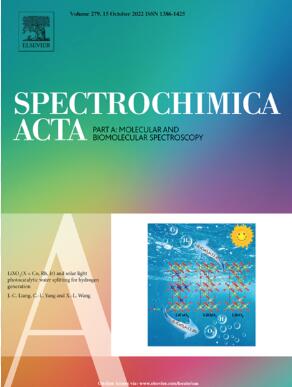A triphenylamine-based multifunctional fluorescent probe for Cu2+ and Zn2+ as well as mechanochromism and application in latent fingerprints
IF 4.3
2区 化学
Q1 SPECTROSCOPY
Spectrochimica Acta Part A: Molecular and Biomolecular Spectroscopy
Pub Date : 2025-02-17
DOI:10.1016/j.saa.2025.125915
引用次数: 0
Abstract
In this study, a new versatile fluorescent probe, YH (N, N-((1E, 1′E)-((phenylazanediyl)bis(4, 1-phenylene))bis(methanylylidene))di(picolinohydrazide)), was created and synthesized. YH demonstrated the capability to continuously detect Cu2+ and PO43− in EtOH/HEPES solutions (95/5, V/V, HEPES = 10 mmol, pH = 7.4). Additionally, YH could function as a ratiometric fluorescent probe for identifying Zn2+. The interaction mechanisms among YH and Cu2+ as well as Zn2+ were elucidated through 1H NMR titration, mass spectrometry, and FT-IR spectroscopy. Moreover, YH displayed aggregation-induced luminescence in methanol and water. Furthermore, the solid form of YH exhibited notable mechanochromism characteristics, transitioning from blue to green after grinding, and this process was reversible by ethanol vapor fumigation. Due to YH’s high sensitivity to mechanical stimuli, a starch @ YH composite was successfully developed for detecting latent fingerprints. Meanwhile, YH was utilized for detecting Cu2+ and Zn2+ in environmental water samples and was effectively employed with test papers for ion detection, demonstrating broad application prospect.

本研究创建并合成了一种新型多功能荧光探针 YH(N, N-((1E, 1′E)-((phenylazanediyl)bis(4, 1-phenylene))bis(methanylylidene))di(picolinohydrazide) )。YH 能够连续检测 EtOH/HEPES 溶液(95/5,V/V,HEPES = 10 mmol,pH = 7.4)中的 Cu2+ 和 PO43-。此外,YH 还可以作为一种比率荧光探针来识别 Zn2+。通过 1H NMR 滴定法、质谱法和傅立叶变换红外光谱法,阐明了 YH 与 Cu2+ 和 Zn2+ 的相互作用机制。此外,YH 在甲醇和水中显示出聚集诱导发光。此外,固体形式的 YH 表现出显著的机械变色特性,研磨后会从蓝色转变为绿色,乙醇蒸汽熏蒸可逆转这一过程。由于 YH 对机械刺激具有很高的灵敏度,因此成功开发出一种淀粉与 YH 的复合材料,用于检测潜藏指纹。同时,YH 还被用于检测环境水样中的 Cu2+ 和 Zn2+,并与试纸一起有效地用于离子检测,显示出广阔的应用前景。
本文章由计算机程序翻译,如有差异,请以英文原文为准。
求助全文
约1分钟内获得全文
求助全文
来源期刊
CiteScore
8.40
自引率
11.40%
发文量
1364
审稿时长
40 days
期刊介绍:
Spectrochimica Acta, Part A: Molecular and Biomolecular Spectroscopy (SAA) is an interdisciplinary journal which spans from basic to applied aspects of optical spectroscopy in chemistry, medicine, biology, and materials science.
The journal publishes original scientific papers that feature high-quality spectroscopic data and analysis. From the broad range of optical spectroscopies, the emphasis is on electronic, vibrational or rotational spectra of molecules, rather than on spectroscopy based on magnetic moments.
Criteria for publication in SAA are novelty, uniqueness, and outstanding quality. Routine applications of spectroscopic techniques and computational methods are not appropriate.
Topics of particular interest of Spectrochimica Acta Part A include, but are not limited to:
Spectroscopy and dynamics of bioanalytical, biomedical, environmental, and atmospheric sciences,
Novel experimental techniques or instrumentation for molecular spectroscopy,
Novel theoretical and computational methods,
Novel applications in photochemistry and photobiology,
Novel interpretational approaches as well as advances in data analysis based on electronic or vibrational spectroscopy.

 求助内容:
求助内容: 应助结果提醒方式:
应助结果提醒方式:


